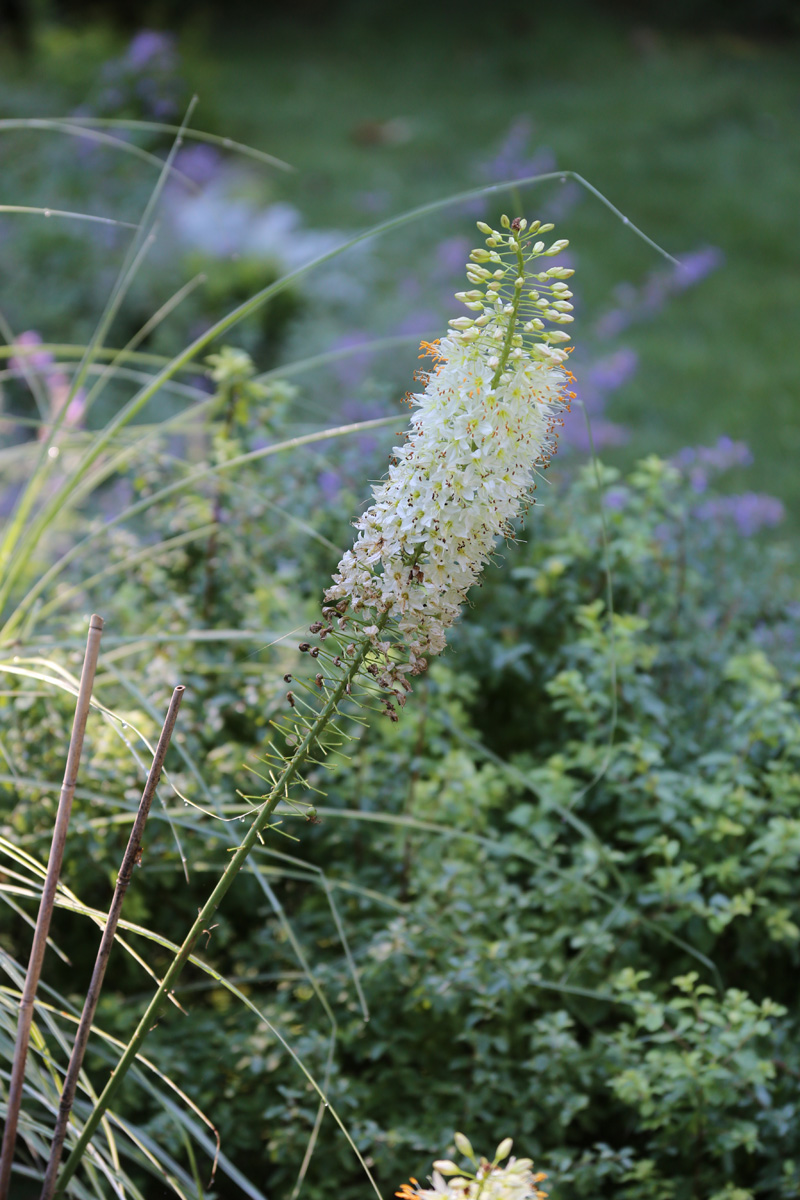
Spring is fading fast, and memories of the daffodil and tulip bulbs that we filled our beds and containers with are starting to fade also. Now is the time to think about summer-flowering bulbs to help a with the transition between spring and full summer. Just as a heads-up: Most gardens and sellers tend to lump tubers, corms, and rhizomes into a generic grouping referred to as “bulbs.” Many later-blooming bulbs are available from local nurseries and online resources. The common ones such as lilies (Lilium spp. and cvs., Zones 4–9), lily of the Nile (Agapanthus spp. and cvs., Zones 6–10), gladiola (Gladiolus spp. and cvs., Zones 8–10), and alliums (Allium spp. and cvs., Zones 4–9) are well and good, but two of my favorite bulbs bring a little more excitement to garden beds.
Foxtail lilies sport impressively huge blooms that create instant focal points
Foxtail lily (Eremurus robustus, Zones 5–8) bulbs are not really lilies or bulbs at all but easy-to-grow tubers. Also called “desert candles,” they are dramatic and unusual. Their tall, often singular spikes of vibrant flowers are a great addition to the garden bed when spring bulbs are fading. The tubers look like giant fuzzy spiders. They are best planted on a cone of soil about 6 inches below grade with the “legs” hanging down to prevent rot. Fill in the hole with good soil, firm it around the tuber gently, and water well. In full sun with good drainage, foxtail lilies are remarkably hardy. They’re drought tolerant once established, although a bit of wind protection is a good idea when they’re in bloom. This plant has naturalized in my garden, and the 4- to 5-foot flower spikes are impressive from a distance, but the individual blossoms that cluster together along the spike are more amazing upon closer inspection. As a bonus, pollinators adore foxtail lilies. I have two beloved cultivars: ‘Cleopatra’ and ‘White Beauty’.

‘Cleopatra’ foxtail lily (E. robustus ‘Cleopatra’)
I’ve planted this variety with its lush orange-peach flowers in my ornamental grass garden between Itoh peonies (Paeonia cv., Zones 3–9) and in front of a tall, dark burgundy barberry (Berberis cv., Zones 4–9). Its hues resemble a sunset and are extremely eye-catching.

‘White Beauty’ foxtail lily (E. robustus ‘White Beauty’)
This is a very statuesque plant and was added to the back of my all-white garden this year. It has subtler coloring than many other varieties, but that makes it no less alluring.
Pineapple lilies add an exotic flare to any bed or border
This is another uncommon yet impressive summer bulb. Pineapple lilies (Eucomis spp. and cvs., Zones 7–10) are neither lilies nor pineapples (are you sensing a theme here?) but instead wonderful bulbs that really add pizzazz to a garden bed. They start blooming in the Pacific Northwest in May and continue through late summer or early fall. The little tip of the bloom looks just like the topknot of a pineapple. Pineapple lilies are quickly becoming more popular because of how easy they are to grow. They come in a variety of colors and sizes, with everything from burgundy leaves to spotted stems adding to the excitement. A few choice options are ‘Sparkling Burgundy’ and giant pineapple lily.

‘Sparkling Burgundy’ pineapple lily (E. comosa ‘Sparkling Burgundy’)
Gorgeous deep red new growth and pinkish blooms make this a winning variety. This species prefers to be in a sheltered border. Plant the bulbs in full sun, 6 inches deep, and mulch around the plants once they’ve emerged. This extra protection will ensure they grow and show off their exotic flowers every year.

Giant pineapple lily (E. pallidiflora subsp. pole-evansii)
This is a tough perennial with some drought resistance once established. It sports 4-foot-tall wands of green flowers surrounded by leaves that are always bright emerald.
A few years ago, I started adding more and more summer bulbs to some areas of my garden and have not been disappointed. Now as the spring bulbs begin to fade, I know I have some replacements sizing up in the background to steal the show.
For more Pacific Northwest regional reports, go here.
—Susan Calhoun is the owner of Plantswoman Design in Bainbridge Island, Washington.
Fine Gardening Recommended Products

Ho-Mi Digger - Korean Triangle Blade
Fine Gardening receives a commission for items purchased through links on this site, including Amazon Associates and other affiliate advertising programs.

Dramm Revolution Adjustable 9-Pattern Metal Hose Nozzle
Fine Gardening receives a commission for items purchased through links on this site, including Amazon Associates and other affiliate advertising programs.
- Ergonomic insulated grip
- Maximum pressure of 90 PSI
- Fully adjustable spray pattern
- No trigger lock

The Crevice Garden: How to make the perfect home for plants from rocky places
Fine Gardening receives a commission for items purchased through links on this site, including Amazon Associates and other affiliate advertising programs.























Comments
Log in or create an account to post a comment.
Sign up Log in